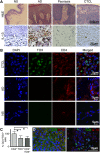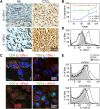Interleukin-13 is overexpressed in cutaneous T-cell lymphoma cells and regulates their proliferation
- PMID: 25628470
- PMCID: PMC4424628
- DOI: 10.1182/blood-2014-07-590398
Interleukin-13 is overexpressed in cutaneous T-cell lymphoma cells and regulates their proliferation
Abstract
Cutaneous T-cell lymphomas (CTCLs) primarily affect skin and are characterized by proliferation of mature CD4(+) T-helper cells. The pattern of cytokine production in the skin and blood is considered to be of major importance for the pathogenesis of CTCLs. Abnormal cytokine expression in CTCLs may be responsible for enhanced proliferation of the malignant cells and/or depression of the antitumor immune response. Here we show that interleukin-13 (IL-13) and its receptors IL-13Rα1 and IL-13Rα2 are highly expressed in the clinically involved skin of CTCL patients. We also show that malignant lymphoma cells, identified by the coexpression of CD4 and TOX (thymus high-mobility group box), in the skin and blood of CTCL patients produce IL-13 and express both receptors. IL-13 induces CTCL cell growth in vitro and signaling through the IL-13Rα1. Furthermore, antibody-mediated neutralization of IL-13 or soluble IL-13Rα2 molecules can lead to inhibition of tumor-cell proliferation, implicating IL-13 as an autocrine factor in CTCL. Importantly, we established that IL-13 synergizes with IL-4 in inhibiting CTCL cell growth and that blocking the IL-4/IL-13 signaling pathway completely reverses tumor-cell proliferation. We conclude that IL-13 and its signaling mediators are novel markers of CTCL malignancy and potential therapeutic targets for intervention.
© 2015 by The American Society of Hematology.
Figures



Comment in
-
IL-13 as a novel growth factor in CTCL.Blood. 2015 Apr 30;125(18):2737-8. doi: 10.1182/blood-2015-02-626432. Blood. 2015. PMID: 25931576 No abstract available.
References
-
- Samuelson E. Cutaneous T-cell lymphomas. Semin Oncol Nurs. 1998;14(4):293–301. - PubMed
-
- Diamandidou E, Cohen PR, Kurzrock R. Mycosis fungoides and Sezary syndrome. Blood. 1996;88(7):2385–2409. - PubMed
-
- Sterry W, Mielke V. CD4+ cutaneous T-cell lymphomas show the phenotype of helper/inducer T cells (CD45RA-, CDw29+). J Invest Dermatol. 1989;93(3):413–416. - PubMed
-
- Zackheim HS, Amin S, Kashani-Sabet M, McMillan A. Prognosis in cutaneous T-cell lymphoma by skin stage: long-term survival in 489 patients. J Am Acad Dermatol. 1999;40(3):418–425. - PubMed
-
- Diamandidou E, Colome M, Fayad L, Duvic M, Kurzrock R. Prognostic factor analysis in mycosis fungoides/Sézary syndrome. J Am Acad Dermatol. 1999;40(6 Pt 1):914–924. - PubMed
Publication types
MeSH terms
Substances
Grants and funding
LinkOut - more resources
Full Text Sources
Other Literature Sources
Research Materials

